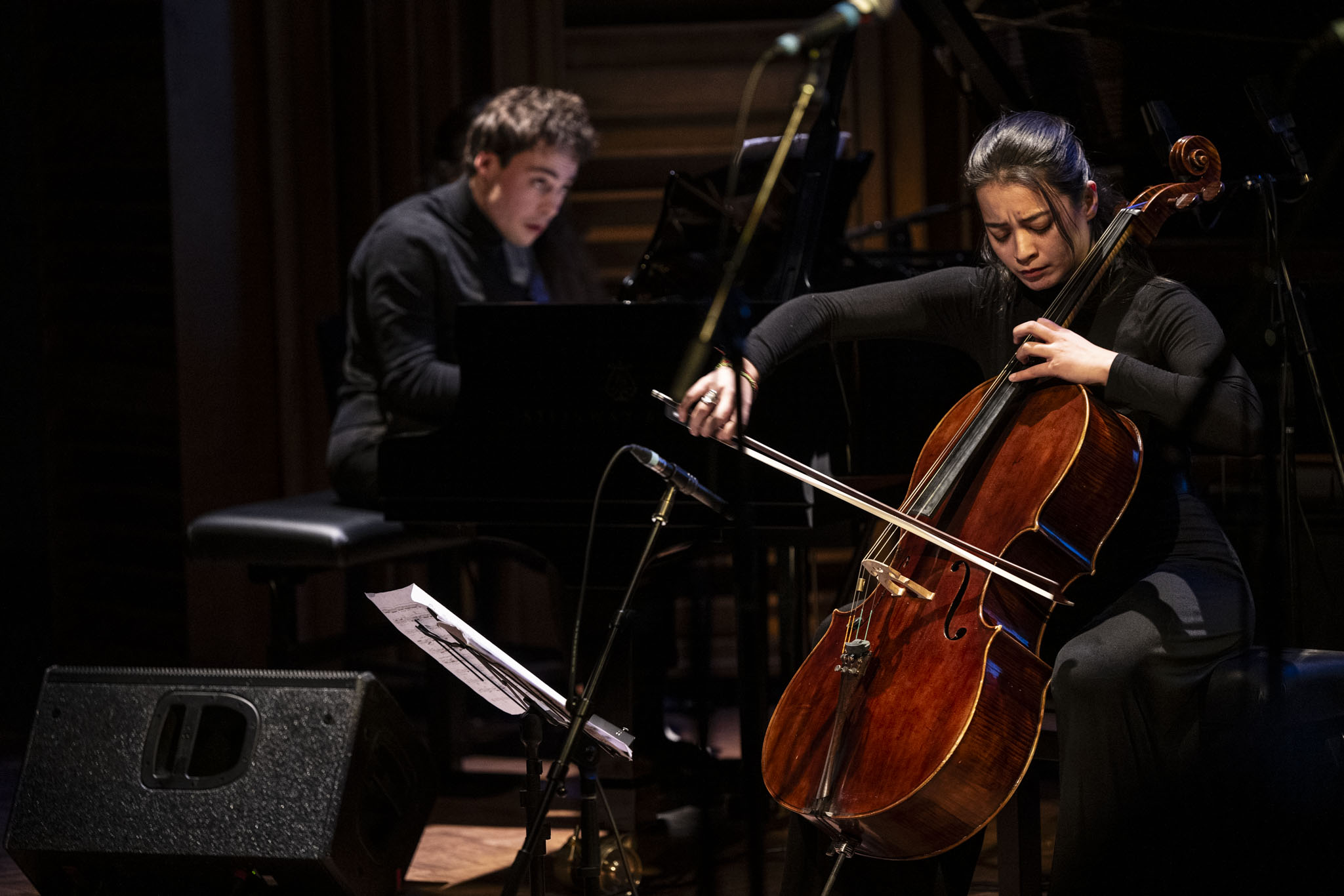
Martin Beau (piano) & Maïa Zifaras (cello) performance of Cello Sonata in D minor by Debussy at Banff Musicians in Residence 2024 Participant Concert 2. Photo by Rita Taylor.
Artistic Credits
Azabache
Project 23.6°N
Program
Aida Shirazi and Ann-Kristin Sofroniou
Lucky Star
Lucky Star is the first episode from the musical podcast series Women Moving created by Ann-Kristin Sofroniou and Aida Shirazi. This episode is on astronaut and scientist Sally Ride who was the first American woman to go to outer space. Using storytelling, original and existing music and sound design, we retell the story of Ride’s first travel onboard space shuttle Challenger in June 1983. Lucky Star combines facts and fiction to create a new dimension of Sally’s mission and highlight one particular side story that, given the circumstances, preceded the groundbreaking achievement of this pioneer.
Shahriyar Jamshidi
Hazhān
With each performance, Shahriyār Jamshidi illustrates the oral musical narrative of the Kurdistan and reverberates the sound of Kurdish mountains on his Kamānche.
Miranda Currie with Azabache, Aditya Bhat and Pin-hui Tsai
Reflect and Rejoice
Broken Man
Do You Know Why?
Mahsi Cho
Northern Indigenous Singer-Songwriter Miranda Currie will be presenting new songs with new arrangements. Broken Man will be released on her newest album, later in 2025.
INTERMISSION (15 minutes)
Azabache
Soundtrack Buenos Aires
I. After Milonga
II. Torque
III. Arnia
IV. Baruyo
Azabache presents new tangos for string quartet, emerging from the actual scene of Buenos Aires. Offering a fresh and surprising interpretation of Argentine popular music within the classical string quartet format. The performance includes new material developed during their artistic residency at Banff Centre.
Eleanor Stalcup
Saints
Saints is a live electronic piece inspired by Virgil Thompson and Gertrude Stein's 1928 opera, Four Saints in Three Acts. The opera is marked by a lavish camp aesthetic and a general unintelligibility and plotlessness that forces the audience to gain meaning purely from the sensual experience of the production. This piece is an exploration of unintelligibility as queer practice within contemporary electronic composition, using Stein's text as a basis. How does this medium complement and contrast with the function of unintelligibility in the original opera, and does the concept hold up outside of conventional aesthetics?
Project 23.6°N
Chiok-Kú Bô Khòaⁿ Lí: A Letter Home
Chi-Yen Huang 黃祈諺
A question asked by another mote of dust in the microturbulence...
This piece examines the identity challenges faced by a Taiwanese composer living and studying in America. Inspired by Bernard’s reflections in Virginia Woolf's The Waves, the composer views identity as fluid and shaped by relationships. The concept of "coming home" prompts a reflective exploration of significant life experiences, such as family outings in nature, which influence their artistic expression. The resulting composition sonically captures the tension of self-discovery in a foreign land, illustrating the nuances and dynamics of their evolving identity through sound.
Ya-Lan Chan 詹雅蘭
Triptych: Scattered : I. red
Triptych: Scattered is a suite of three pieces that explores the ongoing search for one’s identity, shown by a journey pieced together from fragmented memories. Each movement features a different sense of scatteredness through varied musical presentations, structures, and tunings, interwoven with elements of Taiwanese lullaby and folklore. In I. Red, the piano carries the melody of, “虎姑婆” (“Tiger Auntie”) a children’s song used to scare children to sleep. Different tunings and subtle shifts in piano timbre create a backdrop of longing, but increasingly disrupted by other fragments, leaving a new creature in its wake. This piece is commissioned by Project 23.6°N.
A tale from long ago, my mother shared with me,
In the depths of night, where shadows softly flee,
There lives the Tiger Auntie, roaming 'neath the stars,
Crying children, hush your tears, or she'll leave tiny scars,
Sleepless baby, find rest before you play,
For she might nibble at your toes, if you choose to stay awake.
I remember vividly, with eyes gently shut tight,
“Tiger Auntie, spare me now, as I drift off tonight.”
So good little children, close your eyes with care,
Dream sweet dreams in slumber's arms, no need for fear to share.
Chih-Yun Wang 王之筠
After Imagining Dancing in the Moonlight
Theme
Var. 1 Mouth Harp (Jew's harp)
Var. 2 Coryphee with the Moon
Var. 3 The Voice of Amis Old People
Var. 4 The Rite of Millet
Var. 5 Dancing in the Moonlight
“Where there is dance, there must be song; where there is song, there must be dance” is a famous saying from the Ami’s, an indigenous ethnic group in Taiwan. "After Imagining Dancing in the Moonlight” adopts the pitches and rhythm patterns from the Ami folk song “Dance while Watch the Moon,” and accentuates the timbre collisions of different musical instruments to showcase the experience of learning the Amis' posture dance. The shouts or chanted accompaniment serves as the foundation of the piece, with each variation further revealing a greater sense of the Ami people’s spirit of perseverance and endurance.
Banff Centre is grateful to the following supporters for making this program possible: the Government of Alberta, the Government of Canada and the Canada Council for the Arts.










